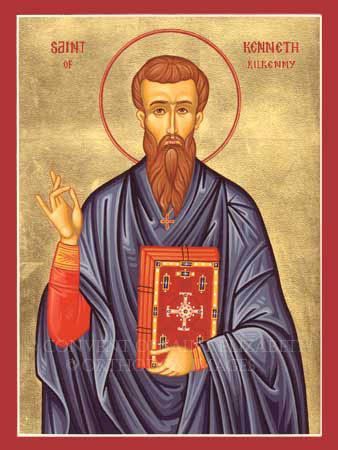
Image Source of St. Canice taken from Pinterest
Much of the material below has been patterned from Omnium Santorum Hiberniae; it’s narration favours a clearer understanding of St. Canice which we deem preferrable.
______________________________________________________
Brief Summary
Canice, also known as Cainnech or Kenneth in Scotland is one of the greatest Irish ascetics and most venerated saints in Scotland after St. Patrick and St. Brigid. He was ascetic in the sense that he lived as a hermit in solitude on islands doing penance. He is patron of Kilkenny, as sometimes he is referred simply as Kenny. Canice was a man of great eloquence and learning, he wrote a commentary on the Gospels, known for centuries as ‘’Glas-Chainnigh’’, or the “Chain of St. Canice”. He established monasteries in Ireland and Scotland.
_____________________________________________________
The Story of our saint
Canice was born in 515 or 516, at Glengiven, in the Valley of the Roe, in present day Co. Derry. He was descended from Corco Dalann or Ui-Dalainn; a Waterford tribe. The tribe dwelt on an island referred to in the Saint’s Life as “Insula Nuligi,” believed to be Inis-Doimhle on the river Suir. Canice’s father was a bard who settled in Glengiven with his wife Maul, under the favour and protection of the chief of Cianachta. In the ”Irish Saints”, (preserved in the College of Salamanca) Meaula or Mealla is given as name of the mother of St. Canice.
The early years of Canice were spent tending to the chieftain’s flocks. God then called Canice to pastor His faithful elect. Soon Canice became a disciple of St. Finnian of Clonard and studied at his monastery, (a centre of ascetics). He had for his companions, like Columkille, Kieran of Clonmacnoise, Comgall, Brendan, and other notable saints, collectively considered the twelve Apostles of Ireland. Later Canice lived at Glasnevin Monastery near present day north Dublin city where he became friends with the great ascetics, Sts. Ciaran and Comgal under the tuition of St. Mobhi.
When a plague broke out in Ireland, the saint moved for a while to Wales. There he stayed at Llancarvan Monastery, on the banks of the Severn, under St. Cadoc. St. Canice had the special love and virtue for transcribing the sacred Scriptures. But above all his virtues, he placed great practice in obedience. One Welsh anecdote we can regale, was while Canice was engaged in transcribing, suddenly the monastery bell sounded. The ringing summoned him for another task. Canice immediately left, his unfinished transcribing, and his half formed letter ”o”, and hastened at once to new duties now demanded of him. Thenceforth, the abbot favoured Canice exceedingly.
Canice continued his religious formation in Wales and in c. 545 he was ordained priest. Canice went to Rome for a blessing from the reigning pontiff. He then returned to Ireland and established an important monastery at ‘’Aghaboe’’ in County Laois. ‘’Aghaboe” means “the little field of a cow.” Under St. Canice, Aghaboe became the chief monastery and spiritual centre of Ossory. It was his treasure-house of graces, and favourite school where generations of his spiritual children lived and prayed, until old age and burial. The rich pastures of Aghaboe gave her monastery a distinct sense of grandeur.
After 562 St. Canice moved to Scotland, where he is known as St. Kenneth. There he built a great monastery on Inchkenneth (“Kenneth’s Isle”) to the north of Iona in Argyl and Bute. He made the monastery of Inchkenneth his mission centre. St. Kenneth was already friends with St. Columba of Iona from their time in Ireland. Together they travelled through the highland country, preaching and baptizing Picts. Columbia and Kenneth visited King Brude of the Picts and performed successful missionary work. To convert the Picts was to put their lives in great peril; but they succeeded!
St. Canice died at the monastery of Aghaboe in the 600. He is celebrated in Ireland on the 11th October, as well as being celebrated in Scotland and Wales.
____________________________________________________
Anecdotes of Nature
The saint liked to live as a hermit on small islands. He loved to communicate with nature and animals. Thus, once he ordered mice to go away when they nibbled his shoes; on another occasion he rebuked birds for making a loud noise on a Sunday – and they instantly obeyed their master. A deer solicitously held the saint’s personal copy of the Bible on its horns while he was reading it. That was clever use of his time, doing spiritual reading while in transit.